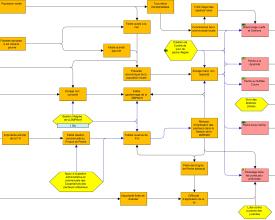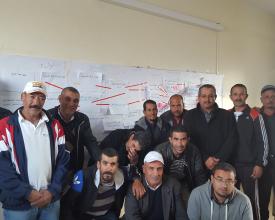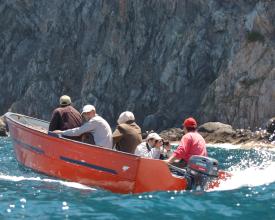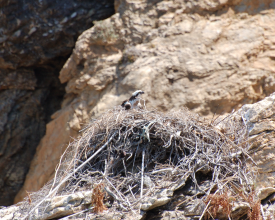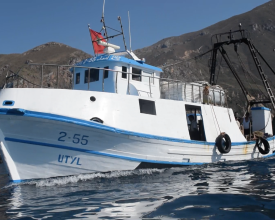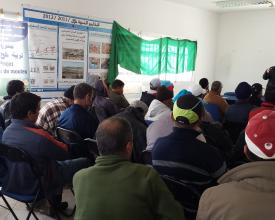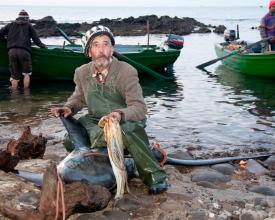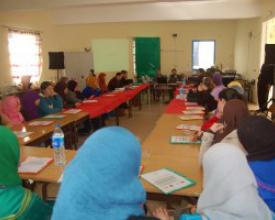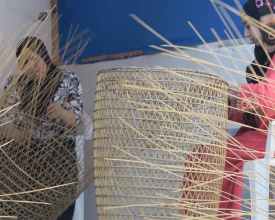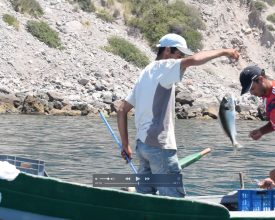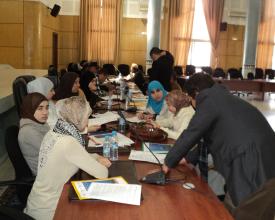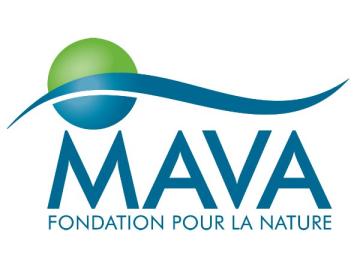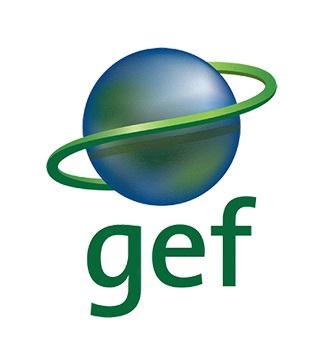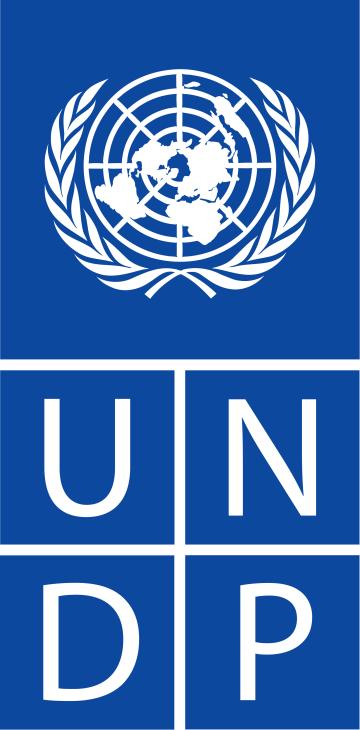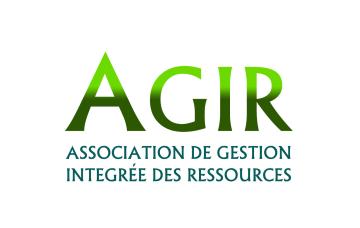
Gestion durable des ressources marines du Maroc
Mise en œuvre d'un programme de planification participative basé sur l'écosystème au profit des pêcheurs artisanaux opérant en Méditerranée. Dans le cadre de ce programme, les pêcheurs ont pu identifier les défis posés par le chalutage illégal et la pêche à la dynamite. La création d'un comité de suivi leur a permis de participer à la lutte contre ces menaces. Leur revenu global a augmenté grâce à la gestion commerciale des produits de la pêche dans les coopératives nouvellement créées.
Contexte
Défis à relever
- Le chalutage illégal dans les zones peu profondes des AMP entraîne la destruction de l'habitat et des zones de reproduction des espèces démersales. Les stocks d'espèces démersales sont en déclin.
- La pêche à la dynamite menace les stocks de poissons.
- Le braconnage des nids de balbuzards a provoqué un déclin de la population locale.
- Le manque d'organisation des pêcheurs artisanaux ne favorise pas la lutte contre ces multiples défis.
Emplacement
Traiter
Résumé du processus
Le premier bloc concerne l'écosystème marin et les espèces cibles (comme le pygargue à tête blanche). Les menaces directes qui pèsent sur ce biotope et les espèces cibles sont étudiées dans le cadre d'activités de recherche ciblées et impliquent toutes les parties prenantes. Ces activités de recherche sont présentées dans le bloc 4.
Le bloc 2 aborde un facteur indirect de la restauration du biotope et de la protection des espèces menacées par l'établissement de zones de non-prélèvement : le renforcement de l'implication des pêcheurs artisanaux dans le plan de gestion des ressources marines de la zone marine du parc national.
Un autre facteur indirect de conservation, abordé par le bloc 3, est l'amélioration du niveau de vie des pêcheurs artisanaux de 30 % dans la zone côtière de l'AMP. En outre, la planification participative d'une stratégie de commercialisation des produits de la pêche soutient les activités génératrices de revenus. Ce bloc permet aux pêcheurs artisanaux de s'organiser et de former un groupe de pression en faveur de la conservation.
Le bloc 5 vise à capitaliser sur l'expérience d'AGIR à travers un réseau de coopératives de pêche méditerranéennes visant à créer davantage d'AMP et à contribuer aux objectifs Aichi-Targets 6 et 11.
Blocs de construction
Participation des parties prenantes à la gestion des zones marines
Objectifs
- Améliorer les connaissances sur les espèces menacées en menant des recherches et des suivis ciblés.
- Impliquer les communautés locales dans la gestion des ressources côtières et marines, des biotopes et des populations menacées.
Déroulement du projet
Un atelier a été organisé pour lancer le projet et établir un climat de confiance entre les parties prenantes. Au moins 50 représentants de la Gendarmerie, de la Direction des Pêches Maritimes du Haut Commissariat aux Eaux et Forêts et à la Désertification, des communautés locales de pêcheurs et de l'ONG AGIR ont participé à l'atelier participatif.
Un comité de gardiennage multipartite a été élu afin d'impliquer toutes les parties prenantes. Le comité est présidé par le gouverneur de la province d'Al Hoceima.
L'équipe d'AGIR et les pêcheurs sont équipés pour participer à une étude de suivi et d'évaluation participative concernant l'état de conservation des ressources et de l'habitat. Le suivi des espèces phares menacées est mené en coordination avec les autorités compétentes.
Des visites de terrain hebdomadaires ont été organisées pour le suivi du programme de surveillance et de contrôle des activités illégales dans l'AMP.
Un rapport scientifique reflète le nouvel état de conservation (restauration de l'habitat, espèces menacées et ressources marines).
Facteurs favorables
- L'établissement d'un climat de confiance entre les communautés et les partenaires étatiques et institutionnels, avant le lancement effectif du projet
- La maîtrise des méthodes de gestion adaptative et l'éducation participative d'un grand nombre de pêcheurs artisanaux
- L'organisation d'ateliers participatifs pour identifier et corriger les menaces qui pèsent sur l'ensemble de l'écosystème
Leçon apprise
- Les sorties hebdomadaires de suivi et d'entretien participatif doivent être préparées en concertation avec l'administration
- Afin d'impliquer la population locale, au moins vingt participants, parmi lesquels des pêcheurs artisanaux des coopératives, sont soutenus et éduqués. Cette éducation vise à leur donner les moyens de contribuer aux études de suivi et d'évaluation participative de l'état de conservation des ressources et des habitats et au suivi des espèces phares menacées.
- Il est nécessaire que les ateliers tiennent compte de l'emploi du temps des pêcheurs (pendant les périodes de mauvais temps ou les pauses).
- Au moins 30 % de la population locale doit être touchée par la campagne de sensibilisation sur la protection des espèces phares dans l'AMP. Cette campagne, menée au cours de la première année du projet, doit être soutenue par la participation des médias locaux et nationaux.
Gestion communautaire des zones interdites à la pêche dans les AMP
Objectif
Les pêcheurs artisanaux de trois coopératives sont formés et impliqués dans le plan de gestion des ressources de l'aire marine du parc national.
Processus
Organisation de 2 x (3) sessions de formation sur la planification participative comme outil de gestion des ressources dans l'aire marine du parc national.
Proposition de zones d'interdiction de capture ou de zones de pêche réservées (FRA) dans l'aire marine du parc national.
Un rapport de suivi des captures dans l'aire marine du parc national est en cours de préparation en collaboration entre les pêcheurs qui ont fourni les données et l'équipe d'AGIR qui a rédigé le rapport, lequel a servi à évaluer les bénéfices du projet.
Facteurs favorables
- L'établissement d'un climat de confiance entre les communautés et les partenaires étatiques et institutionnels, avant le lancement effectif du projet.
- La validation des zones d'interdiction de pêche ou des FRA par les pêcheurs et les autorités respectives.
- Le rapport de suivi des captures de produits de la pêche dans l'aire marine du parc national doit être communiqué aux pêcheurs d'AGIR par les experts afin d'évaluer les bénéfices du projet.
Leçon apprise
- Les activités (suivis hebdomadaires sur le terrain et prise en charge participative des espèces) préparées en collaboration avec l'administration, ont permis une augmentation des ressources halieutiques de 30 %.
- L'implication des acteurs locaux et nationaux dans la restauration des biotopes et des espèces a permis une restauration allant de 20 à 30 % selon les espèces et les écosystèmes.
- Le choix de zones d'interdiction de pêche a été fait par les pêcheurs pour lutter contre la pêche illégale. Les zones de non prélèvement correspondent aux zones marines proches des falaises touchées par le braconnage et la pêche à la dynamite.
- Il est nécessaire que les ateliers tiennent compte de l'emploi du temps des pêcheurs (pendant les périodes de mauvais temps ou les pauses).
- Il est nécessaire qu'au moins 60 % des pêcheurs artisanaux soutiennent les zones d'interdiction.
Gestion commerciale durable des ressources marines dans les AMP
Objectif
La qualité de vie des pêcheurs artisanaux s'est améliorée d'environ 30 % dans la zone côtière de l'AMP grâce à une bonne gestion des ressources. L'AMP contribue également à l'augmentation des revenus grâce à la mise en œuvre d'une stratégie participative visant à commercialiser les produits de la pêche.
Processus
Les coopératives de pêcheurs organisent des ateliers participatifs visant à définir une stratégie de commercialisation des produits de la pêche artisanale. L'objectif est de réduire la pression globale exercée par la pêche dans l'aire marine du parc national.
Création de "fonds de rotation pour la pêche" afin de soutenir les activités génératrices de revenus. Ces fonds sont mis à la disposition des coopératives de pêcheurs opérant dans la zone marine du parc national, mais aussi de leurs épouses.
Facteurs favorables
- L'établissement d'un climat de confiance entre les communautés et les partenaires étatiques et institutionnels, avant le lancement du projet.
- La création d'un fonds rotatif destiné à soutenir la stratégie de commercialisation des produits de la pêche issus de l'aire marine du Parc national.
- Le fonds permet de soutenir le lancement et l'accompagnement d'un projet de valorisation des prix et de la qualité, au profit de la coopérative des femmes et filles de pêcheurs.
- Les fonds rotatifs pour la pêche servent à assurer l'autonomie administrative et financière des coopératives.
Leçon apprise
- Les activités du programme visant à mettre en œuvre une stratégie de commercialisation des produits de la pêche des pêcheurs artisanaux opérant dans l'aire marine du parc national doivent être préparées en consultation avec l'administration.
- L'implication de la population locale est également très importante pour la réussite du projet. Au moins vingt membres du bureau exécutif de la coopérative de pêcheurs artisanaux ont été soutenus et formés pour leur permettre de contribuer à la stratégie de commercialisation des produits de la pêche provenant des coopératives de pêcheurs opérant dans l'aire marine du parc national. Cela a permis de réduire de 30 % la pauvreté d'environ 1 200 pêcheurs artisanaux.
- La viabilité financière du projet est assurée par la planification participative et le soutien des communautés locales à la stratégie de commercialisation durable de leurs produits de la pêche.
Recherche et planification participatives par le biais d'une analyse systémique et prospective de la durabilité
Objectif
Afin d'impliquer les pêcheurs artisanaux dans la conservation des ressources naturelles, l'analyse réalisée a porté sur des sujets socioculturels, économiques et écologiques. L'objectif était de combler le manque de données pour permettre à toutes les parties prenantes de se rendre compte de la diminution initiale de la biodiversité et des solutions apportées par le projet.
Le processus
L'approche participative utilisée par cette étude a permis à toutes les parties prenantes d'accepter les résultats.
L'étude a été réalisée selon une approche systémique comprenant plusieurs composantes :
- Scientifique : "Indicateurs socioculturels, économiques, écologiques".
- Participative : l'étude a impliqué non seulement le porteur de projet, mais aussi les parties prenantes.
- Prospective : l'étude a permis d'identifier des "scénarios actuels, potentiels et alternatifs".
L'analyse systémique a débouché sur un programme d'action intégré pour la gestion durable du secteur de la pêche artisanale dans l'aire marine du parc national.
Facteurs favorables
- La pêche artisanale représente l'une des principales activités économiques de la région. Accessoirement, elle améliore également la qualité de vie des agriculteurs le long du littoral méditerranéen.
- Les principales contraintes à la croissance économique de la pêche artisanale ont un impact négatif sur la qualité des produits, en raison du manque d'infrastructures de débarquement et de commercialisation.
- La fragmentation et l'isolement de la flottille, dont profitent les poissonniers, ne permettent pas aux pêcheurs de travailler dans des conditions satisfaisantes.
Leçon apprise
Il est nécessaire de minimiser les contraintes de croissance de la pêche artisanale confinée dans les zones de pêche du parc national. Le renforcement du matériel de pêche doit servir de motivation aux pêcheurs pour respecter notre plan de gestion intégrée.
La définition du secteur de la pêche artisanale reste une étape essentielle dans le processus de mise en œuvre d'un plan d'organisation commerciale, qui doit faire l'objet de propositions de projets futurs.
Sur le plan socioculturel, les villages de pêcheurs sont confrontés à un fort taux d'analphabétisme. La peur de perdre leur emploi se traduit par une fréquence élevée de braconnage, d'utilisation de dynamite ou de produits chimiques et de pêche illégale.
Il serait souhaitable de définir un nouveau plan de zonage pour l'aire marine du parc national, qui réponde aux préoccupations de conservation écologique et pas seulement à celles des ressources halieutiques. Cela garantirait un développement durable pour une future approche de suivi et d'évaluation participative.
Réseau des coopératives de pêche méditerranéennes
Objectif
Un réseau informel de coopératives de pêche méditerranéennes a été mis en place dans les AMP de la Méditerranée.
Processus
Mise en place d'un atelier sur l'échange et le partage des connaissances et des méthodologies de gestion des AMP, au profit des coopératives nationales de pêche artisanale de la Méditerranée.
Mise en place d'un forum en ligne pour l'échange de connaissances, de méthodologies et d'impacts concernant le projet.
Mise en place et publication d'un guide populaire sur l'autogestion des AMP.
Mise en place d'une évaluation externe sur la capitalisation du projet.
Facteurs favorables
La procédure d'échange et de partage a suivi les "normes ouvertes pour la pratique de la conservation" formulées en 2007 par le Conservation Measures Partnership.
Des cours d'informatique ont été organisés pour garantir une utilisation efficace du forum d'échange.
Il a été très utile de préparer deux versions d'un guide vulgarisé sur l'autogestion des AMP : l'une simplifiée, destinée aux pêcheurs, et l'autre plus détaillée, destinée aux gestionnaires, aux coordinateurs de projets et aux institutions.
Leçon apprise
- Le forum doit être établi en consultation avec les pêcheurs et l'administration respective de l'aire marine.
- À la suite du projet, plusieurs coopératives de pêche ont demandé la création d'une AMP selon les normes et l'approche utilisées par AGIR.
- Recherche de financement pour la création de nouvelles AMP
- Mise en place d'une évaluation externe sur la capitalisation du projet
Impacts
Après le projet : Une pêche responsable a vu le jour dans la zone marine protégée du parc national d'Al Hoceima (PNAH) (ZMPNAH) grâce à :
- L'éradication de la pêche à la dynamite et au sulfate de cuivre.
- La réduction notable des perturbations des nids de balbuzards et le doublement du nombre de jeunes balbuzards.
- L'éradication du chalutage illégal à l'intérieur de la ZMPNAH. Nos campagnes de sensibilisation contre la pêche des juvéniles ont contribué à l'adoption en 2013/2014 d'une législation obligeant les chalutiers à embarquer des dispositifs de localisation ; Vessel Monitoring Systems (VMS).
- L'augmentation de l'abondance des ressources marines, estimée à 20 à 30 % parmi les espèces et les écosystèmes. Les parties prenantes locales et nationales ont été impliquées dans la restauration des biotopes et des espèces.
- La réduction de la pauvreté de 30 % pour environ 1 200 pêcheurs artisanaux.
- La viabilité financière du projet grâce à une planification participative et à l'utilisation d'une stratégie de commercialisation durable pour les produits de la pêche provenant de la zone du projet.
Bénéficiaires
Quelque 3 000 pêcheurs artisanaux opèrent en Méditerranée marocaine, dont :
- 700 dans l'AMP d'Alborán
- 500 dans les eaux adjacentes au parc national d'Al Hoceima
- 600 sur le site de la lagune de Mar Chica.
Objectifs de développement durable
Histoire
"En 1987, alors professeur de biologie, j'ai déménagé dans la ville côtière d'Al Hoceima, dans le nord du Maroc, où j'ai travaillé comme bénévole pour le Corps de la paix américain. J'ai commencé à travailler sur la conservation des balbuzards dans ce qui est aujourd'hui le parc national d'Al Hoceima. À l'époque, la conférence de Rio n'avait pas encore eu lieu et très peu de gens au Maroc savaient ce qu'était la conservation. Aujourd'hui, les choses ont changé et je ne suis plus seule !
Une expérience à reproduire
En 2005, j'ai reçu le prix Hassan II pour l'environnement, une consécration nationale importante. Mais je suis également consciente de la nécessité d'impliquer davantage de personnes dans mon travail. En 2008, j'ai donc créé l'Association pour la gestion intégrée des ressources (AGIR), qui vise à préserver la côte méditerranéenne marocaine.
Mon objectif n'était pas de me substituer à la communauté locale, aux pêcheurs artisanaux ou à l'État, mais plutôt de mettre en œuvre un programme basé sur une stratégie et une méthodologie d'échange de connaissances et de savoir-faire. Dans le nord du Maroc, des centaines d'ateliers de recherche et de planification participative ont été organisés, créant une véritable académie communautaire travaillant dans l'intérêt de plus de 3000 pêcheurs et femmes de pêcheurs.
Parmi les résultats concrets obtenus sur le terrain, on peut citer : la mise en place de certaines AMP, qui n'existaient auparavant que sur papier, désormais autogérées par des coopératives de pêcheurs et de femmes de pêcheurs ; l'affinement du zonage des AMP ; la création de nouvelles AMP ; et une responsabilisation accrue en matière d'activités marines.
Aujourd'hui, le parc national d'Al Hoceima, autrefois en proie à la pêche illégale et à l'empiètement des chalutiers, est entré dans une nouvelle ère. Les balbuzards pêcheurs prospèrent, la pêche à la dynamite a pris fin et les pêcheurs gagnent mieux leur vie. Désormais, il ne nous reste plus qu'à partager notre expérience avec d'autres institutions partenaires, non seulement avec le Ministère de la Pêche du Maroc, mais aussi avec d'autres pays du sud de la Méditerranée qui souhaitent s'inspirer de l'approche d'AGIR.
La recette du succès
L'association a su gagner la confiance des pêcheurs artisanaux et des communautés locales d'une part, mais aussi celle des institutionnels et des bailleurs de fonds internationaux d'autre part. Ce gain de confiance a permis à l'association de générer des changements de manière collective et dynamique. La reconnaissance internationale est venue en 2014, lorsqu'AGIR a remporté le Prix Équateur des Nations Unies pour la gestion des ressources marines et côtières. J'ai également été nommé "Héros de la Méditerranée" en 2014 par la Fondation MAVA.
